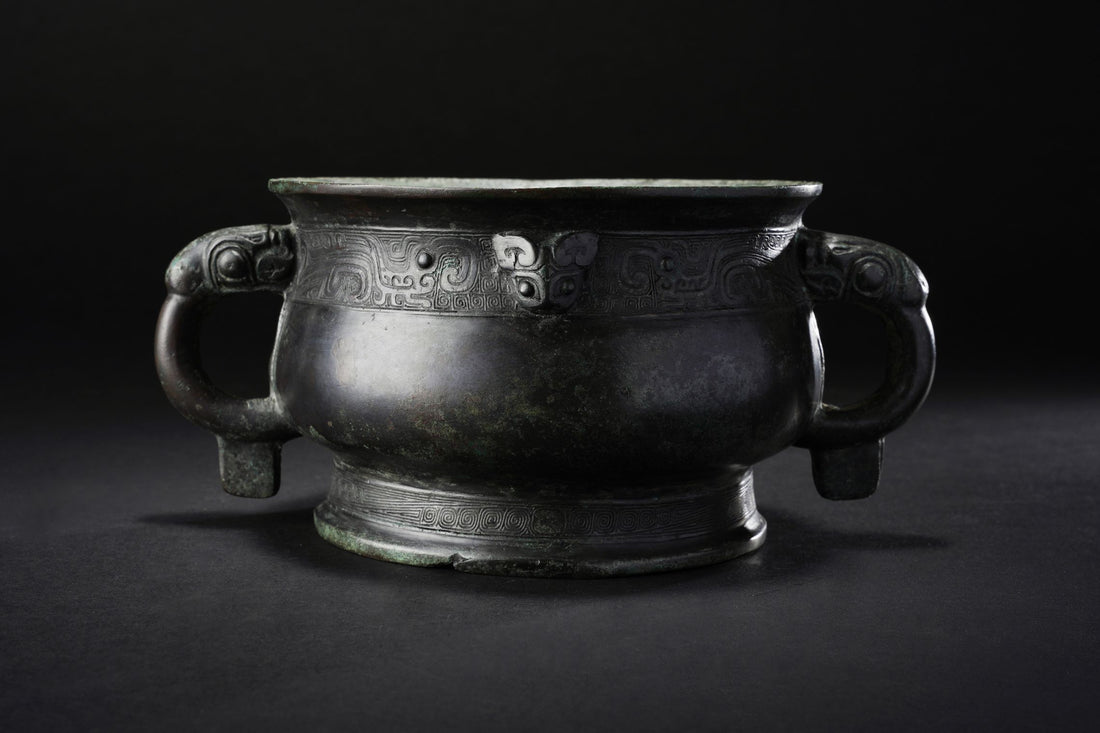
Gui with Two Ears with Phoenix Bird Pattern


As a sacrificial vessel, gui gradually entered the vision of the Shang Dynasty nobles' etiquette life since the early Shang Dynasty. In the Western Zhou Dynasty, gui and ding became a stable ritual combination and were valued by the Zhou Dynasty nobles. The so-called system of ding and gui, that is, the number of ding and gui represents the corresponding aristocratic etiquette status. The "eight gui" recorded in "The Book of Songs: Cutting Wood" is a reflection of this etiquette.


This gui has a wide mouth and thick lip, a vertical neck and a round belly, a high ring foot, and two ears decorated with animal heads, with flat square pendants below. The neck is decorated with a circle of phoenix patterns, with a relief animal head in the middle, and a phoenix on each side facing each other, with a slightly raised phoenix head, a crown with many teeth, and a long tail curled up, which is gorgeous and vivid. In between, there is a thunder pattern against the ground, from the ground pattern to the high relief, which sets off a rich visual level. The abdomen is plain, except for the cloud thunder pattern on the ring foot. The long-tailed phoenix pattern is generally believed to be popular in the middle of the Western Zhou Dynasty. It is a unique aesthetic creation of the Zhou people and can be used as evidence of the age of this gui. There is an inscription on the bottom of the vessel, and the body is covered with copper rust, showing a sense of vicissitudes and antiquity. This vessel has a dignified shape and a distinct solemn atmosphere, exuding the majesty and status of ancient bronze ware. Similar gui can be found in important bronze collections of museums on both sides of the Taiwan Strait: the "Xianfei" gui in the National Palace Museum in Taipei, the "Baoyuan" gui in the Shanghai Museum, and the "Fushi" gui in the National Museum of China, all of which can be compared here.


![8.3"China Shang Dynasty,Bronze wine cup [Fuhao Jue cup][妇好爵杯]](http://bronzc.com/cdn/shop/files/4ee0482982cfa89bb4d1cff3333a55e6_e3ca0b86-22fc-497d-9afd-578c551225a3-2.jpg?v=1733986652&width=533)

![12.8" China Ming Dynasty, Phoenix-patterned bronze vase[Ming Wanli Phoenix-patterned vase][明万历凤纹瓶]](http://bronzc.com/cdn/shop/files/4ee0482982cfa89bb4d1cff3333a55e6_a516991b-2bb9-4b2f-a2b6-4354129d006c.jpg?v=1733986953&width=533)

![14.6" China Eastern Han Dynasty Bronze vessel in the shape of a flying horse,Also known as bronze galloping horse[Horse Stepping on Flying Swallow][马踏飞燕]](http://bronzc.com/cdn/shop/files/4ee0482982cfa89bb4d1cff3333a55e6_aa3fbeb8-e08b-4a44-929a-13411ca8fb17-2.jpg?v=1733987211&width=533)

![5.9"China Tang Dynasty, Bronze of a walking dragon[Tang Walking Dragon][唐走龙]](http://bronzc.com/cdn/shop/files/2_8cb416b9-ebbd-4fe2-a905-b9277f820c16.png?v=1731488701&width=533)
